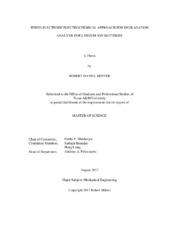| dc.contributor.advisor | Mukherjee, Partha P | |
| dc.creator | Minter, Robert Daniel | |
| dc.date.accessioned | 2020-02-24T20:48:52Z | |
| dc.date.available | 2020-02-24T20:48:52Z | |
| dc.date.created | 2017-08 | |
| dc.date.issued | 2017-07-18 | |
| dc.date.submitted | August 2017 | |
| dc.identifier.uri | https://hdl.handle.net/1969.1/187237 | |
| dc.description.abstract | Lithium-ion batteries are becoming increasingly important as increases in power and energy density pave the wave for them to replace more traditional energy storage systems. Understanding the degradation phenomena that occurs in lithium-ion batteries is important because it allows for the continual improvement in both safety and performance of these complicated systems. A three-electrode system is a powerful method to characterize the degradation phenomena since it allows the study of the decoupled effects of the cathode and anode electrodes.
The objective of this research is to diagnosis and prevent degradation phenomena occurring in lithium-ion batteries. This is done through a multiple step process which includes the development of a reliable three-electrode experimental setup, the electrochemical characterization of the cell through use of potential and electrochemical impedance spectroscopy measurements, and the application of this knowledge to prevent lithium plating and improve cell performance by implementing anode potential based control.
From the anode potential measurements, it was found that the anode potential reached negative values during high C-rate charging. This could then be used to identify the existence of lithium plating. This identification then formed the foundation for the anode-based control. From the impedance measurements, the individual electrode contributions to the overall cell impedance were characterized and were used to explain the changes in cell impedance as a function of the cell state of charge.
After successfully characterizing the lithium-ion cell through potential and impedance data, anode potential based control was implemented which utilized both the anode potential and full cell voltage readings to prevent lithium plating and prevent cell overcharging, simultaneously. The cell capacity retention was improved by limiting the anode potential above a certain threshold value. This showed that lithium plating was occurring and the capacity retention of the cell could be improved by prevention of these degradation phenomena. | en |
| dc.format.mimetype | application/pdf | |
| dc.language.iso | en | |
| dc.subject | three-electrode | en |
| dc.subject | lithium-ion | en |
| dc.subject | degradation | en |
| dc.subject | lithium plating | en |
| dc.subject | reference electrode | en |
| dc.subject | electrochemical impedance spectroscopy | en |
| dc.subject | electrochemical potential | en |
| dc.title | Three-Electrode Electrochemical Approach for Degradation Analysis for Lithium-Ion Batteries | en |
| dc.type | Thesis | en |
| thesis.degree.department | Mechanical Engineering | en |
| thesis.degree.discipline | Mechanical Engineering | en |
| thesis.degree.grantor | Texas A&M University | en |
| thesis.degree.name | Master of Science | en |
| thesis.degree.level | Masters | en |
| dc.contributor.committeeMember | Banerjee, Sarbajit | |
| dc.contributor.committeeMember | Liang, Hong | |
| dc.type.material | text | en |
| dc.date.updated | 2020-02-24T20:48:52Z | |
| local.etdauthor.orcid | 0000-0003-0011-9610 | |


